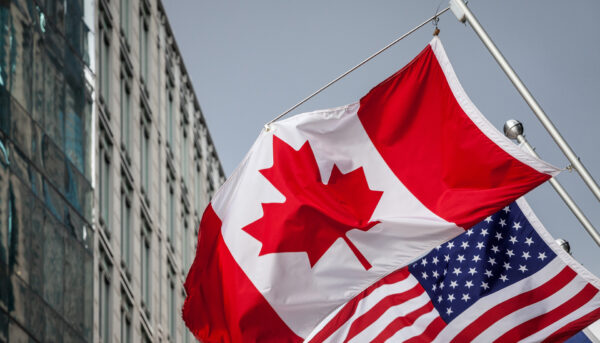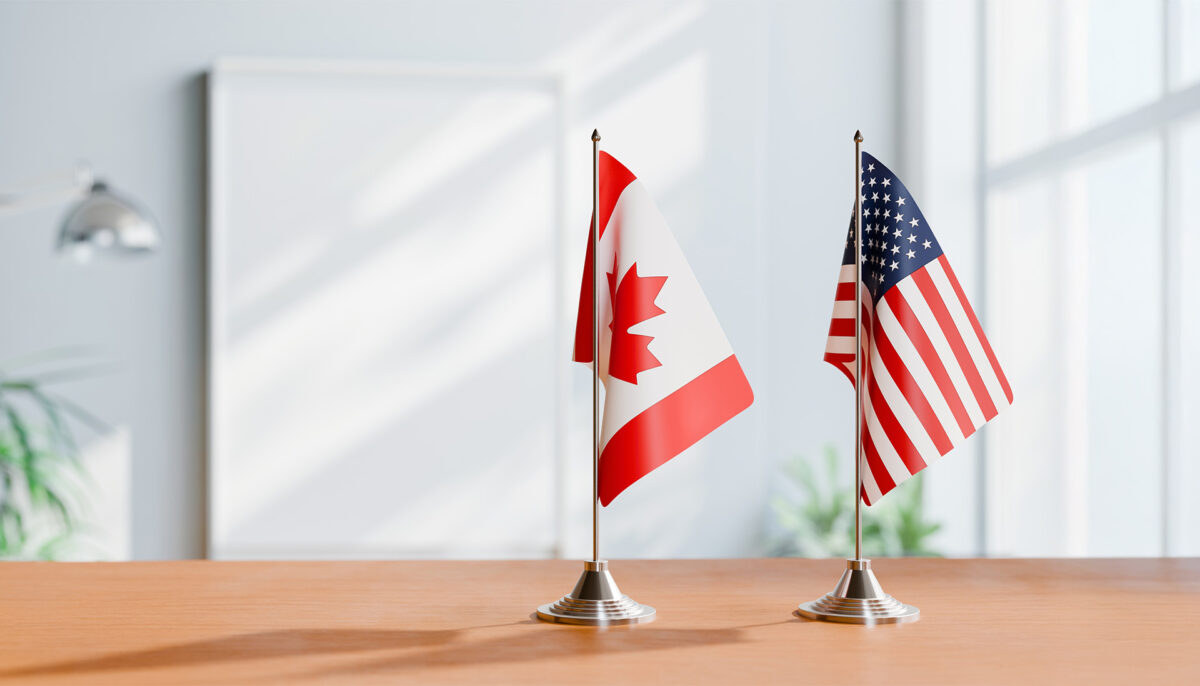Introduction
North America is the world’s largest free trade bloc with its roots tracing back to the 1965 Canada–United States Automotive Products Agreement and the 1989 Canada–United States Free Trade Agreement. In 1994 Mexico was integrated under the North American Free Trade Agreement (“NAFTA”). In 2020 Canadian Prime Minister Trudeau, Mexican President Enrique Peña Nieto, and President Donald Trump signed the current agreement, namely, the Canada-United States-Mexico Agreement (“CUSMA”).
CUSMA represents a market of approximately 500 million people and accounts for 30% of the global economy. In 2023 the CUSMA countries traded approximately $2 trillion worth of goods, equating to around $5.3 billion per day. Firms co-manufacture goods and co-invest in countries within the CUSMA territory. The United States is Canada’s largest source of foreign investment, while Canada is the primary foreign supplier of energy to the US. This interconnected relationship fosters a high degree of economic integration and structured trade policies.
However, recent developments have disrupted long-held assumptions about business, investment, and trade within the CUSMA region. President Trump has announced the imposition of tariffs on Canadian imports, a move that has triggered retaliatory measures from Canada and introduced significant economic uncertainty. As firms navigate these developments, they are now forced to consider duty and import minimization strategies in a previously tariff-free trade environment.
Canada and Mexico have agreed to work together to deal with the US tariffs. However, a protracted trade conflict with the US would be a complex shock to our economy. Firms are now looking for duty and import minimization strategies in cases where they have not had to consider them (i.e., in a CUSMA free trade territory). This article outlines the new US tariffs, Canadian retaliatory measures, and available options for affected businesses.
US tariffs on Canadian goods
America First Trade Policy
On January 20, 2025, President Trump signed a presidential memorandum titled America First Trade Policy. It covers three main areas: (i) addressing unfair and unbalanced trade, (ii) economic and trade relations with the People’s Republic of China (PRC), and (iii) additional economic security matters. The memorandum lays out an aggressive timeline for a CUSMA review.
25% tariff on products of Canada
On February 1, 2025, by way of executive order, President Trump declared an emergency under the National Emergency Act and the International Emergency Economic Powers Act (“IEEPA”). Citing economic security concerns, he issued an executive order under section 1702(a)(1)(B) of the IEEPA Imposing a 25% tariff on goods from Canada, as defined by a Federal Register notice described in the executive order (the “Federal Register Notice”).
10% tariff on energy or energy resources
The executive order also imposes a 10% tariff on Canadian-origin energy products. These duties apply to all applicable imports entering US commerce starting February 4, 2025. Exemptions are limited to goods that meet specific conditions, such as those already in transit before February 1, 2025, with proper documentation and certification submitted to US Customs and Border Protection (“CBP”).
Further provisions of the executive order include:
- The tariffs are in addition to any other applicable duties, fees, or charges.
- If Canada retaliates, the President may expand or increase tariffs further.
- No duty drawback is available for these tariffs.
- No de minimis exemption under 19 US Code § 1312 (bonded smelting and refining warehouses) applies.
- The tariffs will remain in effect unless modified, reduced, or terminated.
Canadian retaliatory surtax
On February 1, 2025, Canada responded with retaliatory measures. It is imposed by the Governor General in Council who, on the recommendation of the Minister of Finance and the Minister of Foreign Affairs, made the United States Surtax Order (2025) (the “US Surtax Order”) under subsection 53(2) and paragraph 79(a) of the Customs Tariff. The first phase is an ad valorem surtax in the amount of 25% levied on US originating goods. The surtax payable is calculated on the value for duty of imported goods in addition to any other duties owing (e.g., in addition to anti-dumping duties). Originating goods are those that are eligible to be marked as “goods of the US” in accordance with the Determination of Country of Origin for the Purpose of Marking Goods (CUSMA Countries) Regulations.
Surtax levied under the US Surtax Order may also increase the Goods and Services Tax (“GST”) levied on imported US originating goods. Import GST is levied at the rate of 5% on the “value of goods” under section 212 of the Excise Tax Act. The value of goods definition includes all duties and taxes levied under the Customs Tariff pursuant to section 215 of the Excise Tax Act.
Phase I of Canada’s surtax
Phase I imposes a surtax on $20 billion worth of US originating goods listed in a schedule to the US Surtax Order. The list of goods in the schedule includes goods such as:
- orange juice, peanut butter, coffee;
- wine, spirits, beer, apparel, footwear; and
- motorcycles, appliances cosmetics, and pulp and paper.
The surtax takes effect upon the US Surtax Order’s enforcement. Goods already in transit at the time of enforcement are exempt. Details and conditions are available in Canada Border Services Agency Customs Notice 25-03.
Phase II of Canada’s surtax
Canada also intends to impose a surtax on a second list of US origin goods worth $125 billion. The second list will be available shortly. The list will be published for a 21-day public comment period prior to implementation. The goods in the second list will likely include:
- passenger vehicles, trucks and buses steel and aluminum products aerospace products; and
- certain fruits and vegetables, beef, pork, dairy products, and more.
The second list of affected goods will undergo a 21-day public consultation before implementation. More details are available in a Department of Finance Canada news release dated February 2, 2025.
Duty and surtax minimization strategies
Commercial importers can take steps to minimize the impact of tariffs and surcharges. Here is an outline of potential options. Experienced advisors can tailor solutions to suit the circumstances.
Gap analysis
A gap analysis is a business tool that can help identify solutions for improving a business. It involves:
- the identification of the current state of a business (e.g., exposed to duty or surtax risk);
- defining the future state (e.g., minimized risk);
- identifying the gap between the two states; and
- develop strategies to bridge the gap.
In order to carry out a gap analysis in this area, it may be necessary to map operations including supply chains and valuation methods.
Sensitivity analysis
A sensitivity analysis is a method for evaluating how changes in system inputs affect its output. In this case, it helps firms identify the impact of duty costs on operations. Knowing the cost of increased tariffs or surtaxes can help firms make decisions on whether to adjust production process or supply chains.
Canadian remission applications
Canada is taking steps to mitigate the impact of the surtax on workers and firms. It will launch a remission process. Remission is the cancellation of Crown debt and can be granted under various statutory authorities. It is generally allowed on the basis of exceptional circumstances. Amongst other things an emphasis will be placed on the hardship that a surtax would impose, potential impact to Canadian jobs and the economy, and alternative sources for US goods. This will allow firms to request exceptional relief from the surtaxes. See the following linked document from the Department of Finance: Process for requesting remission of tariffs that apply on certain goods from the US.
Canadian duties relief/Duty drawback
Canada’s duties relief and duty drawback programs will be available for surtax that is levied on US origin goods. The right to obtain duties relief and duty drawbacks is subject to the provisions of CUSMA.
US Duty exclusion requests
Section 4 of the executive order states that the Secretary of Homeland Security, in consultation with the Secretary of the Treasury, the Attorney General, and the Secretary of Commerce, is authorized to take such actions, including adopting rules and regulations, and to employ all powers granted to the President by IEEPA as may be necessary to implement the order. The IEEPA provides the President with authority to issue regulations under 50 U.S.C. 1704. Therefore, it may be open to the President to issue rules and regulations for duty exclusion applications. At this time it is unclear if and how an exclusion process will be established. The Federal Register may provide updates on available exclusions, and companies should closely monitor it for more information on any developments.
Valuation methods
Businesses may explore legal valuation strategies to reduce dutiable value. In Canada the valuation of goods is calculated in accordance with rules set out in the Customs Act. Any applicable adjustments should be considered when declaring the value for duty of goods.
For US imports, it is sometimes possible to use an intercompany sale or a “first sale” which causes the export of the goods to the US as the basis for the valuation of goods. For example, there may be a first sale between a contract manufacturer and a middleman, then a second sale between a middleman and the importer.
The Nissho Iwai American Corp. v. United States case (982 F.2d 505, Fed. Cir. 1992) reaffirmed that a manufacturer’s price may be used if the transaction is at arm’s length and the goods are destined for US export.
Importers should obtain advice before adopting a valuation method in order to withstand a customs audit.
Review and update commercial agreements
Businesses should review contractual terms related to customs compliance to:
- Reallocate tariff risks.
- Adjust Incoterms (International Commercial Terms).
- Introduce price adjustment or cost-sharing clauses.
- Implement hardship clauses for renegotiation.
- Mandate collaboration on tariff exclusions, remission applications, or duty drawbacks.
More information
The US tariffs and Canada’s retaliatory measures mark a significant shift in CUSMA trade relations. Businesses must proactively assess their exposure, explore relief mechanisms, and implement risk mitigation strategies. Ongoing policy developments and legal proceedings will continue to shape the landscape, making it essential for firms to stay informed and agile in their trade practices.
The situation respecting US tariffs and Canadian countermeasures is evolving quickly and it is important to stay updated with current information. Please contact our Global Trade and Customs Group at Miller Thomson LLP for more information on the latest developments, options, and strategies for dealing with the US tariffs and the Canadian surtax.
*Moments after we published this article on February 3, 2025, President Trump and Prime Minister Trudeau agreed to a 30-day pause in the implementation of US tariffs on products of Canada and the Canadian retaliatory surtax on goods originating in the US. President Trump stated that this is just “an initial outcome” and that during the pause “he will see if a final economic deal can be reached”. Firms are now taking measures to minimize the risk posed by US tariffs and Canadian surtax.
These developments reflect a shift in trade policy towards the use of tariffs as leverage to achieve policy goals and as a source of revenue to offset tax cuts. Firms should factor in the overhead of potential tariffs in their business models for the immediate future.








